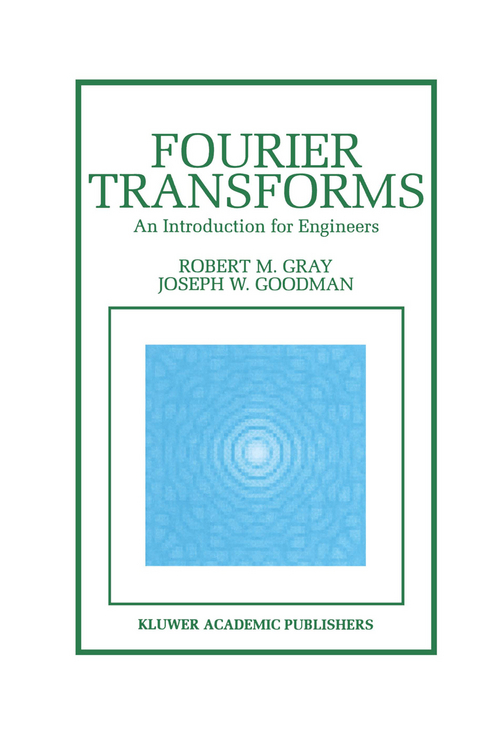
Fourier Transforms
Springer (Verlag)
978-0-7923-9585-0 (ISBN)
1 Signals and Systems.- 1.1 Waveforms and Sequences.- 1.2 Basic Signal Examples.- 1.3 Random Signals.- 1.4 Systems.- 1.5 Linear Combinations.- 1.6 Shifts.- 1.7 Two-Dimensional Signals.- 1.8 Sampling, Windowing, and Extending.- 1.9 Probability Functions.- 1.10 Problems.- 2 The Fourier Transform.- 2.1 Basic Definitions.- 2.2 Simple Examples.- 2.3 Cousins of the Fourier Transform.- 2.4 Multidimensional Transforms.- 2.5 * The DFT Approximation to the CTFT.- 2.6 The Fast Fourier Transform.- 2.7 * Existence Conditions.- 2.8 Problems.- 3 Fourier Inversion.- 3.1 Inverting the DFT.- 3.2 Discrete Time Fourier Series.- 3.3 Inverting the Infinite Duration DTFT.- 3.4 Inverting the CTFT.- 3.5 Continuous Time Fourier Series.- 3.6 Duality.- 3.7 Summary.- 3.8 * Orthonormal Bases.- 3.9 * Discrete Time Wavelet Transforms.- 3.10 * Two-Dimensional Inversion.- 3.11 Problems.- 4 Basic Properties.- 4.1 Linearity.- 4.2 Shifts.- 4.3 Modulation.- 4.4 Parseval’s Theorem.- 4.5 The Sampling Theorem.- 4.6 The DTFT of a Sampled Signal.- 4.7 * Pulse Amplitude Modulation (PAM).- 4.8 The Stretch Theorem.- 4.9 * Downsampling.- 4.10 * Upsampling.- 4.11 The Derivative and Difference Theorems.- 4.12 Moment Generating.- 4.13 Bandwidth and Pulse Width.- 4.14 Symmetry Properties.- 4.15 Problems.- 5 Generalized Transforms and Functions.- 5.1 Limiting Transforms.- 5.2 Periodic Signals and Fourier Series.- 5.3 Generalized Functions.- 5.4 Fourier Transforms of Generalized Functions.- 5.5 * Derivatives of Delta Functions.- 5.6 * The Generalized Function ?(g(t)).- 5.7 Impulse Trains.- 5.8 Problems.- 6 Convolution and Correlation.- 6.1 Linear Systems and Convolution.- 6.2 Convolution.- 6.3 Examples of Convolution.- 6.4 The Convolution Theorem.- 6.5 Fourier Analysis of Linear Systems.- 6.6 The Integral Theorem.- 6.7Sampling Revisited.- 6.8 Correlation.- 6.9 Parseval’s Theorem Revisited.- 6.10 * Bandwidth and Pulsewidth Revisited.- 6.11 * The Central Limit Theorem.- 6.12 Problems.- 7 Two Dimensional Fourier Analysis.- 7.1 Properties of 2-D Fourier Transforms.- 7.2 Two Dimensional Linear Systems.- 7.3 Reconstruction from Projections.- 7.4 The Inversion Problem.- 7.5 Examples of the Projection-Slice Theorem.- 7.6 Reconstruction.- 7.7 * Two-Dimensional Sampling Theory.- 7.8 Problems.- 8 Memoryless Nonlinearities.- 8.1 Memoryless Nonlinearities.- 8.2 Sinusoidal Inputs.- 8.3 Phase Modulation.- 8.4 Uniform Quantization.- 8.5 Problems.- A Fourier Transform Tables.
| Erscheint lt. Verlag | 30.6.1995 |
|---|---|
| Reihe/Serie | The Springer International Series in Engineering and Computer Science ; 322 |
| Zusatzinfo | XX, 361 p. |
| Verlagsort | Dordrecht |
| Sprache | englisch |
| Maße | 155 x 235 mm |
| Themenwelt | Mathematik / Informatik ► Informatik |
| Naturwissenschaften ► Physik / Astronomie ► Mechanik | |
| Technik ► Elektrotechnik / Energietechnik | |
| ISBN-10 | 0-7923-9585-9 / 0792395859 |
| ISBN-13 | 978-0-7923-9585-0 / 9780792395850 |
| Zustand | Neuware |
| Haben Sie eine Frage zum Produkt? |
aus dem Bereich


